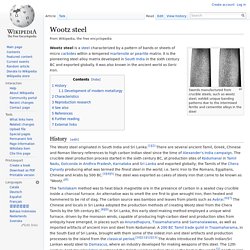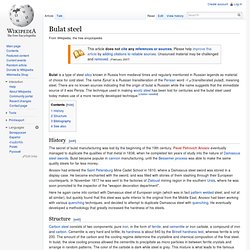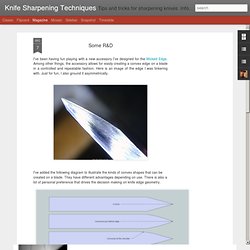

Wootz steel. Swords manufactured from crucible steels, such as wootz steel, exhibit unique banding patterns due to the intermixed ferrite and cementite alloys in the steel Wootz steel is a steel characterized by a pattern of bands or sheets of micro carbides within a tempered martensite or pearlite matrix.

It is the pioneering steel alloy matrix developed in South India in the sixth century BC and exported globally. It was also known in the ancient world as Seric Iron. History[edit] The Wootz steel originated in South India and Sri Lanka.[1][2] There are several ancient Tamil, Greek, Chinese and Roman literary references to high carbon Indian steel since the time of Alexander's India campaign. The Tamilakam method was to heat black magnetite ore in the presence of carbon in a sealed clay crucible inside a charcoal furnace. [edit] From the 17th century onwards, several European travelers observed the steel manufacturing in South India, at Mysore, Malabar and Golconda. Characteristics[edit] See also[edit] Bulat steel. Bulat is a type of steel alloy known in Russia from medieval times and regularly mentioned in Russian legends as material of choice for cold steel.

The name булат is a Russian transliteration of the Persian word پولاد (transliterated pulad), meaning steel. There are no known sources indicating that the origin of bulat is Russian while the name suggests that the immediate source of it was Persia. The technique used in making wootz steel has been lost for centuries and the bulat steel used today makes use of a more recently developed technique. [citation needed] History[edit] The secret of bulat manufacturing was lost by the beginning of the 19th century. Anosov had entered the Saint Petersburg Mine Cadet School in 1810, where a Damascus steel sword was stored in a display case. Structure[edit] Since cementite is essentially a ceramic, this also accounts for the famous sharpness of the Damascus (and bulat) steel. Bibliography[edit] The Mystery of Damascus Blades, by John D.
See also[edit] Some R&D. I've been having fun playing with a new accessory I've designed for the Wicked Edge.

Among other things, the accessory allows for easily creating a convex edge on a blade in a controlled and repeatable fashion. Here is an image of the edge I was tinkering with. Just for fun, I also ground it asymmetrically. I've added the following diagram to illustrate the kinds of convex shapes that can be created on a blade. They have different advantages depending on use. I have heard of three benefits of convex edges. A convex edge has more metal supporting it like a Gothic arch supports a structure. The third benefit has to do with rounding off the shoulders of the bevel to reduce drag through the cut. Main Index - Knifeforums.com - Intelligent Discussion for the Knife Enthusiast - Powered by FusionBB.
Michigan residents, visitors and concerned knife users please take the time to read the press release below.

AKTI is making a difference for knife users! Missy Beyer Open Door Media American Knife & Tool Institute PRESS RELEASE April 20, 2012 For Immediate Release Contact: Jan Billeb Executive Director (307) 587-8296 [email]akti@AKTI.org[/email] Michigan Bill Will Repeal Switchblade Prohibition! The American Knife & Tool Institute (AKTI) is urging all resident and travelers to Michigan to contact their legislators about an important piece of legislation that will repeal the switchblade prohibition in the State of Michigan and reduce the current prohibition on fixed blade knives.
Passage of HB 5544 will add the Wolverine State to the growing number of states that do not outlaw switchblades and keep its over 10 million residents plus visitors from potential criminal charges. Rep. "I carry a knife with me each day.